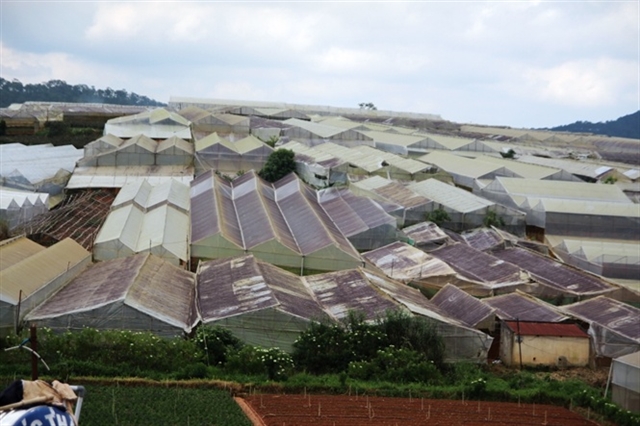 Society
Society


|
| The increase in the number of greenhouses in Đà Lạt has had a negative impact on the climate and landscape of this popular tourist city. — Photo nongnghiep.vn |
ĐÀ LẠT — A rising number of greenhouses in Đà Lạt City and other surrounding areas is causing a headache for authorities due to the negative impacts they have on the climate and landscape of the famous tourist resort city.
Associate Professor Nguyễn Mộng Sinh, former chairman of Lâm Đồng Province’s Union of Science and Technology Associations, said greenhouses should only be used where necessary because high-density development had broken up the scenic landscape of the popular destination.
He said they were also the main cause of agricultural land erosion and flooding.
Nguyễn Văn Sơn, vice chairman of Đà Lạt City's People's Committee, said there were currently no specific regulations on greenhouse planning.
The uncontrolled development of greenhouses at a fast speed had broken the landscape and urban beauty, he said.
Additionally, some types of vegetables and flowers did not suit greenhouses, but many people still tried to grow them.
These greenhouses caused sedimentation in ponds, lakes and stream beds, which would result in flooding in the city, according to Sơn.
Phan Thanh Sang, chairman of the Đà Lạt Flower Association, said to ensure the sustainable development of plants and vegetables, greenhouses also needed to have standard cooling systems and ventilation windows.
Authorities needed to map out a plan and develop greenhouses appropriately for each area, except forest land.
The Tây Nguyên (Central Highland) province of Lâm Đồng has recorded great achievements from hi-tech agricultural development in recent years, including in Đà Lạt City.
Vegetable and flower greenhouses have been built in most cultivation areas in traditional villages including Thái Phiên (Ward 12), Vạn Thành (Ward 5), and wards 7 and 8 of Đà Lạt.
Greenhouses in which owners were applying synchronous hi-tech agricultural solutions have achieved average revenue of VNĐ1 billion to VNĐ3 billion per hectare.
Đà Lạt's People's Committee reported the city's total agricultural cultivation land was about 10,500 hectares, of which greenhouses accounted for over 2,554 hectares.
From 2017 to 2019, many greenhouses previously used to grow vegetables were switched to growing flowers and strawberries due to their higher economic value.
Citizens living in the centre of the city have also built and developed greenhouses.
Localities with a high density of greenhouses include Ward 12 (with greenhouses accounting for 83.7 per cent of the total cultivation area), while the rate in Ward 5, Ward 7 and Ward 8 is over 60 per cent.
Sang said that thanks to greenhouses, many local businesses and farmers could earn billions of đồng each year.
Võ Văn Tuấn, a resident in Thái Phiên Village, said that in recent years the city had been flooded on rainy days because the greenhouses covered the surface area of the soil so the rainwater couldn't seep down.
“It is time to have expert assessment and planning for the development of hi-tech agricultural zones and greenhouse standards in the largest vegetable and flower producing region in Việt Nam,” he said. —VNS




